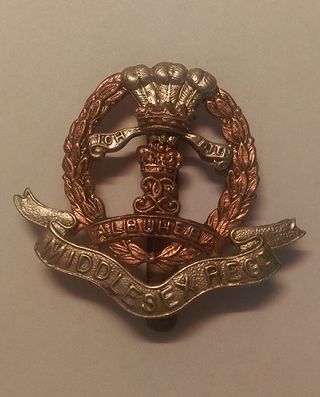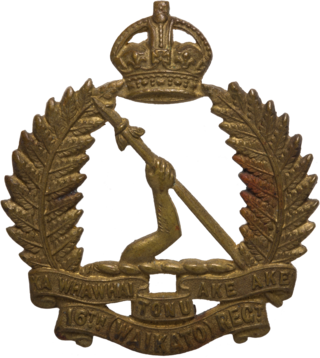
The Royal New Zealand Infantry Regiment is the parent administrative regiment and corps of regular and reserve infantry battalions in the New Zealand Army. It was originally formed in 1947 with a singular Regular regiment and multiple reserve regiments. Over time, the regiments were turned into battalions, the reserve units amalgamated and more regular units raised and disbanded. Currently, the Regiment currently consists of two regular and three reserve battalions. Throughout its existence, units raised in this regiment have served and deployed on operations in Malaya, Vietnam, Borneo and various United Nations peacekeeping operations.
The Rifles is an infantry regiment of the British Army. Formed in 2007, it consists of four Regular battalions and three Reserve battalions, plus a number of companies in other Army Reserve battalions. Each battalion of The Rifles was formerly an individual battalion of one of the two large regiments of the Light Division. Since formation the regiment has been involved in combat operations, first in the later stages of the Iraq War and in the War in Afghanistan.
The Wellington West Coast and Taranaki Regiment was a Territorial Force unit of the New Zealand Army. It was originally formed in 1948 by the amalgamation of two separate regiments:

The Middlesex Regiment (Duke of Cambridge's Own) was a line infantry regiment of the British Army in existence from 1881 until 1966. The regiment was formed, as the Duke of Cambridge's Own (Middlesex Regiment), in 1881 as part of the Childers Reforms when the 57th (West Middlesex) and 77th (East Middlesex) Regiments of Foot were amalgamated with the county's militia and rifle volunteer units.
When a World War I medal was issued to a member of Commonwealth forces, it was issued with a Service Number, Rank, Name and Regiment. This information should be on every medal that was issued during the First World War.
The 9th Battalion, London Regiment was a Territorial Army infantry battalion of the British Army. The London Regiment was formed in 1908 in order to regiment the various Volunteer Force battalions in the newly formed County of London, and the Queen Victoria's Rifles were one of twenty six units brought together in this way.

The 140th Brigade was an infantry brigade formation of the British Army's Territorial Army (TA) that had its origins in a South London Brigade of the former Volunteer Force. It served on the Western Front in the First World War and was recreated during the Second World War where it served only in the United Kingdom as a training formation.

The 5th/7th Battalion, Royal New Zealand Infantry Regiment is an Army Reserve infantry battalion of the Royal New Zealand Infantry Regiment with its headquarters in Trentham, New Zealand.

The 17th Battalion, The London Regiment , was a unit of Britain's Territorial Force formed in 1908 from Volunteer corps dating back to 1859. It saw considerable service on the Western Front, at Salonika and in Palestine during World War I. It served as an infantry regiment during World War II before conversion to an artillery unit in 1947 and subsequent amalgamation in 1967.
The Wellington Infantry Regiment was a military unit of the New Zealand Expeditionary Force (NZEF) raised for service in the First World War. It saw service in the Gallipoli Campaign (1915) and on the Western Front (1916–1919). The regiment was formed by grouping together companies from four different territorial regiments base in the Wellington Military district.

The Taranaki Regiment was a territorial infantry regiment of the New Zealand Military Forces. The regiment traced its origins to the Taranaki Volunteer Rifle Company, a volunteer corps formed in 1858 and which saw service in the New Zealand Wars. The volunteer corps also provided men to the New Zealand contingents sent to South Africa during the Second Boer War and in 1911 became the 11th Regiment (Taranaki Rifles). During the First World War, the regiment provided a company to each of the battalions of the Wellington Infantry Regiment and saw combat at Galipolli and on the Western Front. After the war the regiment was renamed the Taranaki Regiment and remained in New Zealand for home defense during the Second World War. Men from the regiment, however, served with the 19th, 22nd, 25th and 36th Battalions of the Second New Zealand Expeditionary Force. In 1948, the Taranaki Regiment was amalgamated with the Wellington West Coast Regiment and became the Wellington West Coast and Taranaki Regiment.

The Hawke's Bay Regiment was a territorial infantry regiment of the New Zealand Military Forces. The regiment traced its origins to the Napier Rifle Volunteer Rifles, a volunteer corps formed in 1863 and which would later amalgamate with other volunteer corps to form the 9th Regiment in 1911. During the First World War, the regiment provided a company to each of the battalions of the Wellington Infantry Regiment and saw combat at Galipolli and on the Western Front. After the war the regiment was renamed the Hawke's Bay Regiment and remained in New Zealand for home defense during the Second World War. Men from the regiment, however, served with the 19th, 22nd, 25th and 36th Battalions of the Second New Zealand Expeditionary Force. The regiment had a close relationship with the Ruahine Regiment, which was detached and reabsorbed by the Hawke's Bay regiment on two separate occasions. In 1964, the Hawkes Bay regiment was amalgamated with the Wellington Regiment and become the 7th Battalion, Royal New Zealand Infantry Regiment

The Ruahine Regiment was a Territorial Force Infantry Regiment of the New Zealand Military Forces. It was briefly raised in the 1910s and saw service in the First World War as part of the Wellington Infantry Regiment. It was formed for a second time during the Second World War and was deployed overseas as part of the 3rd Division but never saw combat.

The New Zealand Scottish Regiment was a regiment of the New Zealand Army. It was formed in 1939 as an infantry regiment and raised two battalions during the Second World War. Although the 1st Battalion was sent overseas during the war as part of the 3rd Division, it never saw combat. The regiment was reformed in 1948 as a reconnaissance regiment of the Royal New Zealand Armoured Corps, but by the 1960s had been reduced to two independent squadrons. Various armoured vehicles were utilized by the regiment including Daimler Dingo Scout Cars, Daimler Armoured Cars, Ferret armoured cars and M113a1 armoured personnel carriers. The regiment was eventually disbanded in 2013.

The 2nd Regiment was a territorial infantry regiment of the New Zealand Military Forces. It was formed in 1911 from various volunteer corps raised during the second half of the nineteenth century. Men from the regiment saw combat in the First World War as part of the Canterbury Infantry Regiment. It was amalgamated with the 1st (Canterbury) Regiment in 1921 to form the 1st Battalion, Canterbury Regiment.
The 13th Regiment was a territorial infantry regiment of the New Zealand Military Forces. It was formed in 1911 from various volunteer corps raised during the second half of the nineteenth century. Men from the regiment saw combat in the First World War as part of the Canterbury Infantry Regiment. It was amalgamated with the 12th Regiment to form the 2nd Battalion, Canterbury Regiment in 1921, which was redesignated as the 1st Battalion, Nelson, Marlborough and West Coast Regiment in 1923.
The 12th Regiment was a territorial infantry regiment of the New Zealand Military Forces. It was formed in 1911 from various volunteer corps raised during the second half of the nineteenth century. Men from the regiment saw combat in the First World War as part of the Canterbury Infantry Regiment. The 12th Regiment was amalgamated with the 13th Regiment in 1921, forming the 2nd Battalion, Canterbury Regiment, which was then redesignated as the 1st Battalion, Nelson, Marlborough and West Coast Regiment in 1923.
The Wellington West Coast Regiment was a territorial infantry regiment of the New Zealand Military Forces. The regiment traced its origins to the Wanganui Rifle Volunteers, a volunteer corps formed in 1860. The volunteer corps provided men to the New Zealand contingents sent to South Africa during the Second Boer War and in 1911 became the 7th Regiment. During the First World War, the regiment provided a company to each of the battalions of the Wellington Infantry Regiment, which saw combat at Galipolli and on the Western Front. After the war the regiment was renamed the Wellington West Coast Regiment and remained in New Zealand for home defence during the Second World War. Men from the regiment, however, served with the 19th, 22nd, 25th and 36th Battalions of the Second New Zealand Expeditionary Force. In 1948, the Wellington West Coast Regiment was amalgamated with the Taranaki Regiment and became the Wellington West Coast and Taranaki Regiment.

The Waikato Regiment was a territorial infantry regiment of the New Zealand Military Forces. The Regiment was formed in 1911 as the 16th (Waikato) Regiment and provided service companies to the Auckland Infantry Regiment during the First World War. Men from the Regiment also served with the 18th, 21st, 24th and 29th battalions of the 2nd New Zealand Expeditionary Force during the Second World War. The regiment was absorbed by the 1st Armoured Regiment (Waikato) of the Royal New Zealand Armoured Corps in 1950

The Northland Regiment was a territorial infantry regiment of the New Zealand Military Forces. The Regiment was formed in 1911 and provided service companies to the Auckland Infantry Regiment during the First World War. Men from the Regiment also served with the 18th, 21st, 24th and 29th battalions of the 2nd New Zealand Expeditionary Force during the Second World War. The regiment was amalgamated with the Auckland Regiment in 1964, becoming 3rd Battalion, Royal New Zealand Infantry Regiment.

















